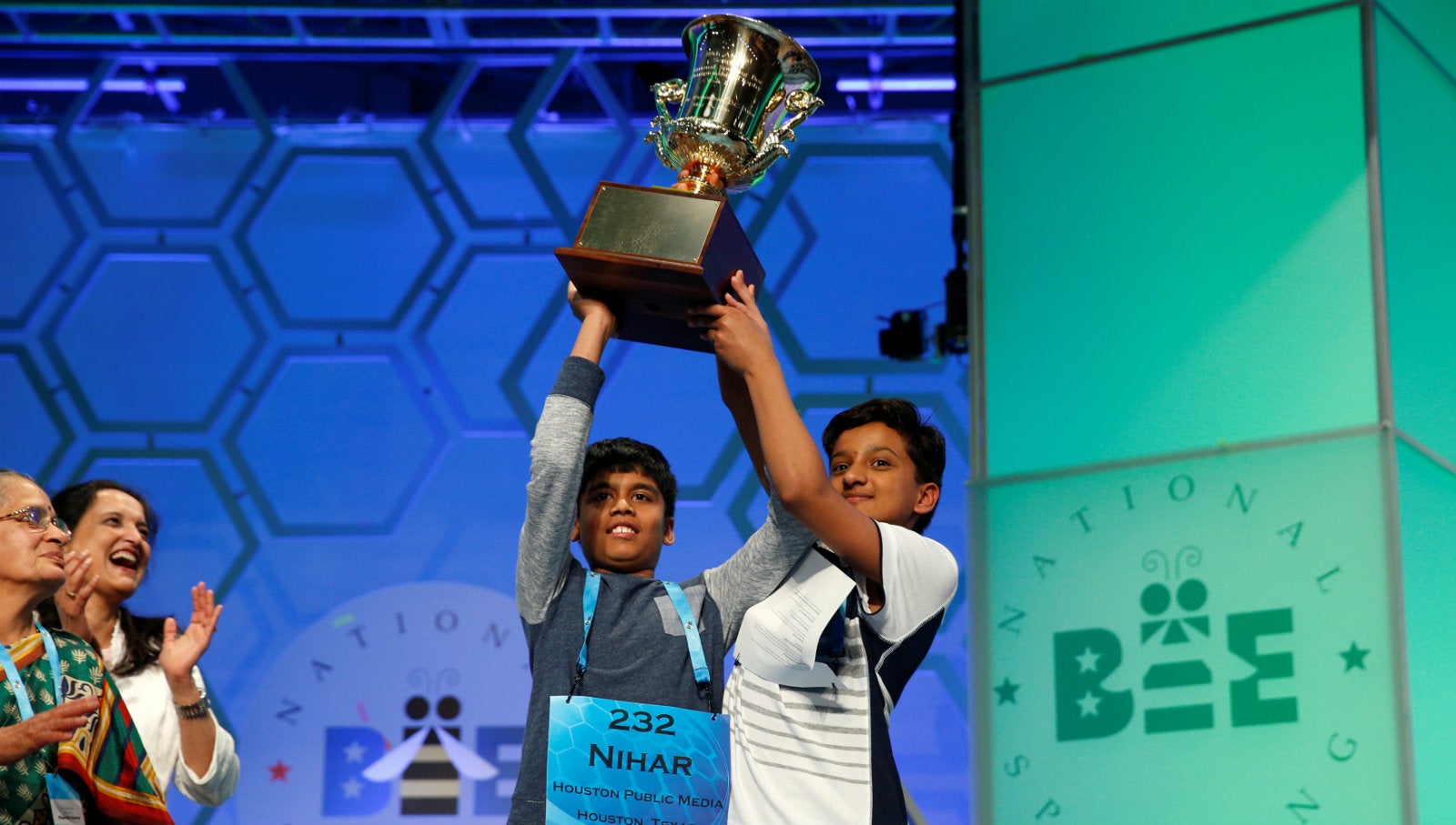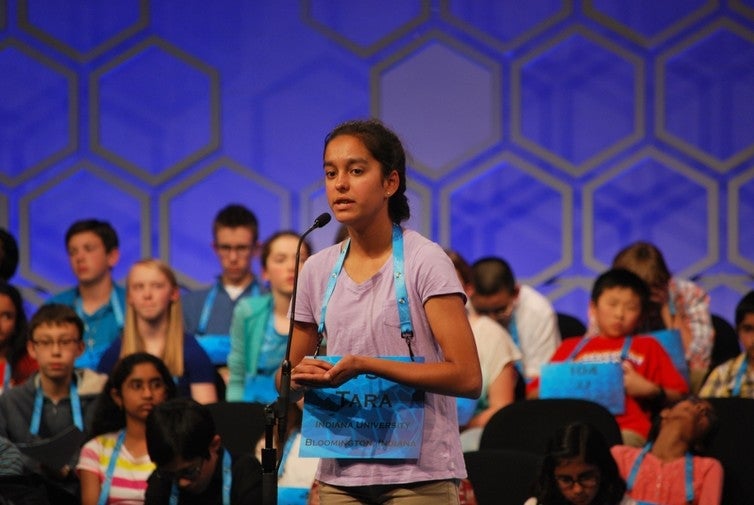Why children of Indian immigrants spell A.M.E.R.I.C.A. better
When spellers win the Scripps National Spelling Bee, audiences always want to know their secret. Yet this question seems to be asked far more in recent years in response to an Indian-American winning streak.


When spellers win the Scripps National Spelling Bee, audiences always want to know their secret. Yet this question seems to be asked far more in recent years in response to an Indian-American winning streak.
South Asian-American spellers have excelled at the National Spelling Bee for nine years in a row, with 2014, 2015 and now 2016 featuring Indian-American co-champions as well.
This year’s winners—Jairam Hathwar from Painted Post, New York and Nihar Janga from Austin, Texas—present a familiar combination of co-champions. Jairam is the younger brother of 2013 co-champion Sriram, who also dueled with a Texan to ultimately share the trophy.
As a topic of intense speculation on broadcast and social media, the wins have elicited comments that range from curiosity to bafflement and at times outright racism. This curiosity is different from past speculation about “whether home-schooled spellers have an advantage.”
The range of responses offers a moment to consider some of the factors underlying the Indian-American success at the bee, as well as how spelling as a sport has changed. Immediately following the 2016 bee, for instance, much of the coverage has focused on the exceedingly high level of competition and drama that characterized the 25-round championship battle that ultimately resulted in a tie.
Since 2013, I have been conducting research on competitive spelling at regional and national bees with officials, spellers and their families, and media producers.
My interviews and observations reveal the changing nature of spelling as a “brain sport” and the rigorous regimens of preparation that competitive spellers engage in year-round. Being an “elite speller” is a major childhood commitment that has intensified as the bee has become more competitive in recent years.
Let’s first look at history
South Asian-American spelling success is connected to the history of this ethnic community’s immigration to the United States.
For instance, the 1965 Hart-Cellar Act solicited highly trained immigrants to meet America’s need for scientists, engineers and medical professionals and opened the door to skilled immigration from Asia and other regions. In subsequent decades, skilled migration from South Asia continued alongside the sponsorship of family members.
Today, along with smaller, older communities of Punjabi Sikhs and other South Asian ethnic groups primarily on the West Coast, South Asian-Americans constitute a diverse population that features a disproportionately high professional class, although with differences of class, languages, ethnicities and nationalities—differences that are often overlooked in favor of a narrative of Indian-American educational and professional success.
The question is, what gives the community an edge?
For upwardly mobile South Asian-Americans, success is in part due to moving from one socially and economically advantageous societal position in the subcontinent to another in the United States.
Moreover, the English-speaking abilities of most educated South Asian-Americans clearly give them an edge over immigrants from other countries. My research indicates that fluency developed in English-medium schools—a legacy of British colonialism—makes them ideal spelling interlocutors for their children, despite their variety of British spelling. Members of this population with elite educational qualifications have likewise emphasized the importance of academic achievement with their children.
Also important here are the strong family and community networks that offer social support and economic opportunities. Community-building has not only been important for individuals and families, but also for advertisers and marketers that target Asian-American ethnic communities.
What explains the success?
Over the past few years spelling bees have been established exclusively for children of South Asian parentage.

For instance, the North South Foundation holds a range of educational contests, such as spelling bees, math contests, geography bees and essay writing, among others, whose proceeds contribute to promoting literacy efforts in India. The South Asian Spelling Bee, partnering with the insurance company Metlife, offers a highly competitive bee as well.
Taken together, this “minor league” circuit gives South Asian-American spellers far more opportunities to compete, as well as a longer “bee season” to train and practice.
This is particularly helpful because, as past champions confirm, ongoing practice and training are the key to winning.
Invested families
Another factor to note here is the parental ability to dedicate time to education and extracurricular activities. Predictably, families with greater socioeconomic means are able to devote more resources and time.
These parents are as invested in spelling bees and academic competitions as families with star athletes or musicians might be in their children’s matches or performances. As several parents explained to me, spelling bees are the “brain sports” equivalent of travel soccer or Little League.
Of the 30 families I interviewed, the majority had a stay-at-home parent (usually the mother) dedicated to working with children on all activities, including spelling. In dual-income households, spelling training occurred on weeknights and weekends.
Like elite spellers of any race or ethnicity, South Asian-American spellers I spoke with studied word lists daily if possible, logging in several hours on weekends with parents or paid coaches to help them develop strategies and quiz them on words.
A few parents have been so invested in helping their children prepare that they have now started training and tutoring other aspiring spellers as well.
Like any national championship, the pressure on all spellers at a competition on the scale of the National Spelling Bee is intense. South Asian-American children are already subject to living up to the model minority stereotype and feel no reprieve here.
This is especially important to consider when South Asian-American spellers come from lower socioeconomic classes, but nonetheless succeed at spelling bees.
Among the 2015 finalists, for instance, one was the son of motel owners and a crowd favorite, as I observed. He had competed in the bee several times, and his older sister was also a speller, having made it to nationals once. Remarkably, they prepared for competitions by themselves, with no stay-at-home parent or paid coach.
Another 2015 semifinalist was featured in a broadcast segment living in the crowded immigrant neighborhood of Flushing, New York. When I visited this three-time National Spelling Bee participant in 2014, I realized that she lived in the very same apartment complex that my family did in the 1970s. This Queens neighborhood continues to be a receiving area for Indian-Americans who may not have the economic means to live in wealthier sections of New York City or its suburbs.
Many possible explanations
The point is that the reasons that Indian-American spellers are succeeding at the bee are not easily reducible to one answer.
South Asian-Americans, like other Asian immigrants, comprise varying class backgrounds and immigration histories. Yet it is noteworthy that even within this range of South Asian-American spellers, it is children of Indian-American immigrants from professional backgrounds who tend to become champions.

The time and resources Indian-American families devote to this brain sport, as I have observed, appear to be raising this competition into previously unseen levels of difficulty.
This can take a toll on elite spellers, who have to invest far more time studying spelling than in the past. With more difficult words appearing in earlier rounds of competition, spelling preparation can take up much of their time outside of school.
Nonetheless, they emphasize the perseverance they develop from competitive spelling. They learn to handle increasing levels of pressure, and alongside this, what they identify as important life skills of focus, poise and concentration.
Ultimately, what makes Indian-American children successful at spelling is the same as children of any other ethnicity. They come from families who believe in the value of education and also have the financial means to support their children through every stage of their schooling. And, they are highly intelligent individuals who devote their childhood to the study of American English.
Are they American?
Some comments on social media, however, seem to discount these factors and years of intense preparation to instead focus on race and ethnicity as sole factors for spelling success.
In a refreshing shift in tone, this year’s topics also included the ferocity of Janga’s competition style and the inspiration he drew from his football hero Dez Bryant.
Nonetheless, such comments, directed toward nonwhite children when they win this distinctly American contest, do push us to reflect: what does it mean to be an American now?
In alleging that only “Americans” should win this contest, Twitter racists ignore that these spellers too have been born and raised in the United States. Recent winners hail from suburban or small towns in upstate New York, Kansas, Missouri and Texas. They express regional pride in these locations by mentioning regional sports teams and other distinctive features in their on-air profiles.
With their American-accented English and distinctly American comportment, it is merely their skin color and names that set them apart from a white mainstream.
Like generations of white Americans and European immigrants, Indian-American parents spend countless hours preparing word lists, quizzing their children and creating ways for their children to learn. They encourage their children in whatever they are good at, including spelling.
As a result, they have elevated this American contest to a new level of competition. Clearly, this is an apt moment to expand our definition of what it means to be an American.
This article was originally published on The Conversation. Read the original article.